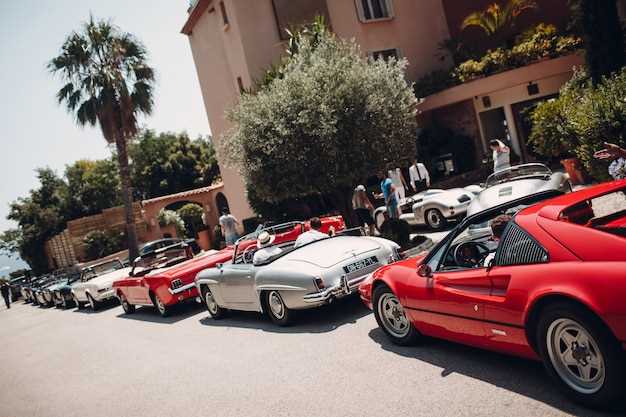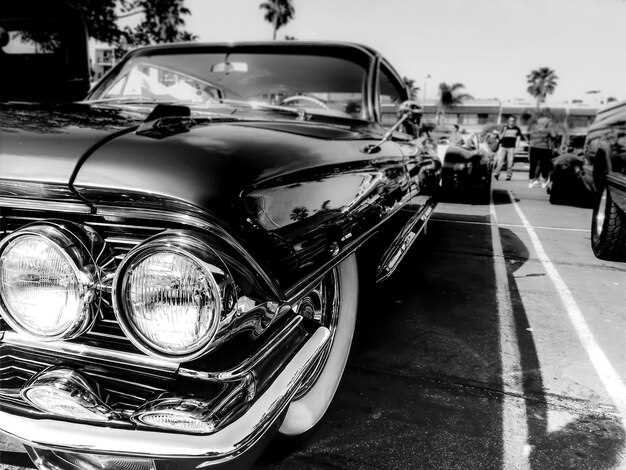
The world of muscle cars has evolved significantly over the decades, bridging the gap between timeless classic designs and modern engineering advancements. Classic muscle cars, renowned for their raw power and unmistakable style, have left a lasting impact on automotive culture. Today, however, modern muscle cars are redefining performance standards, incorporating cutting-edge technology and superior handling capabilities.
This article delves into the performance comparison between classic and modern muscle cars, examining key factors such as engine power, acceleration, and overall driving experience. While classic models often evoke nostalgia with their iconic V8 engines and simple mechanics, today’s counterparts offer enhanced efficiency and structural integrity, attracting a new generation of enthusiasts.
By analyzing various performance metrics, we aim to highlight not only the differences but also the similarities that make muscle cars a beloved category for many. Join us as we explore the evolution from classic powerhouses to their modern interpretations, celebrating the rich heritage of muscle cars while embracing the technological innovations shaping their future.
Engine Specifications: A Side-by-Side Analysis
When comparing modern muscle cars to their classic counterparts, engine specifications play a crucial role in determining performance, efficiency, and driving experience. This analysis examines various aspects of engine design, including displacement, horsepower, torque, and technology.
Displacement: Classic muscle cars typically featured larger displacement engines, often exceeding 400 cubic inches (6.6 liters). For instance, the iconic 1970 Chevrolet Chevelle SS came with a 454 cubic inch (7.4 liters) big-block V8, delivering incredible power for its time. In contrast, modern muscle cars like the Dodge Challenger and Ford Mustang utilize smaller displacement engines with forced induction. The 2023 Ford Mustang GT, for example, offers a 5.0-liter V8 engine that is paired with sophisticated technology to enhance performance without sacrificing efficiency.
Horsepower: Horsepower ratings have seen a significant evolution over the decades. Classic models like the Plymouth Road Runner boasted up to 425 horsepower from their powerful engines, creating a thrilling driving experience. Today, however, manufacturers push the limits of technology, with some modern muscle cars exceeding 700 horsepower. The 2023 Dodge Challenger SRT Hellcat Redeye produces an astonishing 797 horsepower, showcasing advances in engineering and materials that were unimaginable in the classic era.
Torque: Torque is vital for acceleration, and classic muscle cars are known for their robust low-end torque. For instance, the 1969 Chevrolet Camaro could deliver around 400 lb-ft of torque from its big-block engines. Modern iterations, while often utilizing smaller engines, also achieve impressive torque figures. The 2023 Ford Mustang Shelby GT500, equipped with a supercharged 5.2-liter V8, generates around 625 lb-ft of torque, resulting in exhilarating off-the-line performance.
Technology: The technological advancements between classic and modern muscle cars are striking. Classic engines relied on carburetors and basic ignition systems, while modern engines benefit from fuel injection, variable valve timing, and advanced engine management systems. These innovations not only enhance power output but also improve efficiency and reduce emissions. For example, the use of direct fuel injection in modern engines maximizes combustion efficiency, providing both performance and environmental benefits.
In conclusion, while classic muscle cars are celebrated for their raw power and simplicity, modern muscle cars leverage advanced technology to achieve superior performance, efficiency, and drivability. The evolution of engine specifications reflects broader changes in automotive engineering, defining a new era of muscle car performance.
Acceleration Times: Modern vs Classic Evaluations

When comparing modern muscle cars to classic counterparts, acceleration times serve as a crucial indicator of performance capabilities. The advancements in technology and engineering in recent years have created a stark contrast in the acceleration abilities of these vehicles.
Classic muscle cars, often celebrated for their raw power and distinctive charm, typically feature larger displacement V8 engines. However, due to less sophisticated designs and heavier components, their acceleration times tend to lag behind modern offerings. For instance, a classic Chevrolet Camaro from the late 1960s might achieve 0-60 mph in approximately 6 to 7 seconds, primarily influenced by engine size and the absence of modern traction control systems.
In contrast, modern muscle cars benefit from advancements in aerodynamics, lightweight materials, and highly refined engine management systems. These enhancements allow them to harness power more effectively. A contemporary Ford Mustang GT, equipped with a supercharged V8, can reach 0-60 mph in about 3.5 seconds, showcasing the significant leaps in engineering.
The table below illustrates a comparative overview of acceleration times for selected classic and modern muscle cars:
| Car Model | Year | Engine | 0-60 mph (seconds) |
|---|---|---|---|
| Chevrolet Camaro Z28 | 1969 | 350 V8 | 6.5 |
| Plymouth Barracuda | 1970 | 440 V8 | 6.8 |
| Dodge Charger R/T | 1970 | 426 HEMI V8 | 5.5 |
| Ford Mustang GT | 2023 | 5.0 V8 | 3.5 |
| Cherokee SRT | 2021 | 6.2 V8 Supercharged | 3.7 |
This comparison highlights the progression in acceleration capabilities, with classic muscle cars offering a nostalgic appeal while modern iterations provide significantly enhanced performance. Ultimately, enthusiasts appreciate both eras for their unique characteristics and contributions to automotive history.
Handling Characteristics: How Do They Differ?
The handling characteristics of modern muscle cars and classic performance vehicles differ significantly due to advances in technology, design, and engineering. Understanding these differences helps enthusiasts appreciate the unique driving experiences each category offers.
Classic muscle cars, typically produced in the 1960s and 1970s, exhibit the following handling traits:
- Suspension Design: Most classic muscle cars feature simpler suspension systems, often with leaf spring rear setups and basic front struts. This can lead to limited handling precision.
- Weight Distribution: These vehicles often have a front-heavy weight distribution, contributing to understeer in tight corners and a less balanced feel on the track.
- Steering Response: Classic steering systems, usually recirculating ball or manual setups, lack the refinement of modern power steering, resulting in heavier steering feel and less feedback.
- Tire Technology: Older tires are typically narrower with a less sophisticated rubber compound, compromising grip and overall traction.
In contrast, modern muscle cars have undergone significant improvements in handling characteristics:
- Advanced Suspension Systems: Modern vehicles often employ multi-link setups, adaptive dampers, and independent rear suspensions, allowing for improved cornering performance and ride quality.
- Weight Distribution: Many contemporary models are designed with a more balanced weight distribution, which enhances stability and cornering efficiency.
- Precision Steering: Electronic power steering systems provide better feedback and adaptability, allowing for a more connected and responsive driving experience.
- Modern Tires: Wider, performance-oriented tires with sophisticated compounds enhance grip, improve traction, and increase cornering capabilities.
Overall, while classic muscle cars evoke nostalgia with their raw and unrefined handling, modern muscle cars deliver enhanced performance through advanced engineering and technology. This evolution reflects a shift in consumer preferences towards precision and versatility in driving dynamics.
Braking Performance: A Look at Stopping Distances
Braking performance plays a crucial role in the overall safety and handling of vehicles, especially when comparing modern muscle cars and classic performance models. The evolution of braking technology has significantly impacted stopping distances, making modern vehicles more adept at swift and safe deceleration.
When examining stopping distances, several factors come into play:
- Brake System Technology: Modern muscle cars typically feature advanced braking systems, including anti-lock braking systems (ABS), electronic brake distribution (EBD), and larger brake pads. These innovations enhance modulation and control, allowing for shorter stopping distances.
- Tire Composition: The performance tires found on modern cars have superior grip compared to classic tire designs. This increase in traction directly affects how quickly a car can come to a halt.
- Weight Distribution: Modern designs often include improved weight distribution, enabling better handling during braking. This contributes to stopping performance, as balanced weight helps maintain contact between the tires and the road.
In contrast, classic muscle cars may rely on older technology, which can result in longer stopping distances. Their brake systems–often drum brakes–are not as efficient under heavy braking conditions. Key factors influencing their performance include:
- Brake Design: Classic models typically use less effective drum brakes or simpler disc braking systems, which struggle to provide the same immediate stopping power as modern setups.
- Weight and Dimensions: Classic cars often have a heavier design and larger body dimensions, which contribute to increased stopping distances compared to lighter modern vehicles.
- Tire Performance: Tires on vintage models may not be optimized for high-performance driving conditions, resulting in reduced grip during emergency stops.
To illustrate the differences in stopping distances, consider the following example:
- Modern Muscle Car: A 2023 Chevrolet Camaro SS can achieve a stopping distance from 60 to 0 mph in approximately 100 feet.
- Classic Muscle Car: A 1970 Ford Mustang may require upwards of 140 feet to come to a complete stop from the same speed.
This data highlights the advantages modern muscle cars have in terms of braking performance. As muscle car designs continue to evolve, the emphasis on safety and enhanced braking technology will likely remain a focal point for manufacturers, making future comparisons even more favorable for modern models.
Fuel Efficiency: Comparing Miles Per Gallon
When evaluating the performance of modern muscle cars in comparison to classic counterparts, fuel efficiency remains a significant factor. Modern muscle cars have been engineered with advancements in technology that not only enhance power output but also improve fuel economy. This contrasts sharply with classic muscle cars, which often prioritize raw power over efficiency.
Modern muscle cars, such as the Ford Mustang GT and Chevrolet Camaro SS, utilize sophisticated fuel injection systems, turbocharging, and lightweight materials to optimize their performance. These innovations allow them to achieve impressive miles per gallon (MPG) ratings, often ranging between 20 to 30 MPG on the highway, depending on the model and driving conditions.
In contrast, classic muscle cars like the Chevrolet Chevelle SS or the Dodge Charger generally feature larger displacement engines with carburetors, which contribute to lower fuel efficiency. These vehicles typically average around 10 to 15 MPG, reflecting their focus on high horsepower rather than economical driving. This high consumption rate can deter potential buyers who seek both performance and lower fuel costs.
The shift towards greater fuel efficiency in modern muscle cars results not only from regulatory pressures but also consumer demand for vehicles that balance performance and economy. Many modern models offer selectable driving modes, allowing drivers to prioritize efficiency over raw power when desired.
In summary, while classic muscle cars hold nostalgic appeal and deliver exhilarating performance, modern muscle cars excel in fuel efficiency. This evolution demonstrates the automotive industry’s commitment to innovation, catering to an audience that values both power and practicality in their high-performance vehicles.
Technological Advancements: Impact on Performance

In the realm of automotive engineering, technological advancements have profoundly influenced the performance capabilities of modern muscle cars compared to their classic counterparts. Classic muscle cars, characterized by their raw power and straightforward mechanics, often relied heavily on simple designs and large displacement engines. These vehicles prioritized horsepower but typically lacked the sophisticated technology needed for enhanced handling and fuel efficiency.
Modern muscle cars, on the other hand, benefit from cutting-edge technologies that significantly enhance their overall performance. One of the most notable advancements is the integration of turbocharging and supercharging, which allows smaller engines to produce power levels that rival the large V8s of classic models. This not only increases horsepower but also improves torque delivery, resulting in better acceleration and drivability.
Furthermore, modern muscle cars utilize advanced materials like aluminum and carbon fiber, which reduce weight and enhance structural integrity. This weight reduction, when combined with refined aerodynamics, allows for improved handling and agility, elements that were often compromised in classic designs. Enhanced suspension systems, including variable dampers and adaptive controls, provide the necessary versatility to navigate diverse driving conditions, a feature usually absent in classic vehicles.
Additionally, the advent of digital technology has transformed the driving experience. Features such as electronic stability control, advanced traction management systems, and performance-oriented drive modes have made muscle cars safer and easier to handle, even at high speeds. Classic muscle cars, while charming in their simplicity, lack these safety enhancements, making them less accessible for a new generation of drivers.
Moreover, modern muscle cars are equipped with sophisticated engine management systems that optimize fuel injection and timing. These enhancements lead to better fuel efficiency compared to classic muscle cars, which often suffered from poor gas mileage due to inefficient carburetion systems.
In summary, while classic muscle cars hold undeniable charm and a visceral driving experience, technological advancements in modern muscle cars have redefined performance benchmarks. Enhanced power delivery, weight savings, and advanced handling technologies create a driving experience that is not only faster and more efficient but also safer and more enjoyable.




